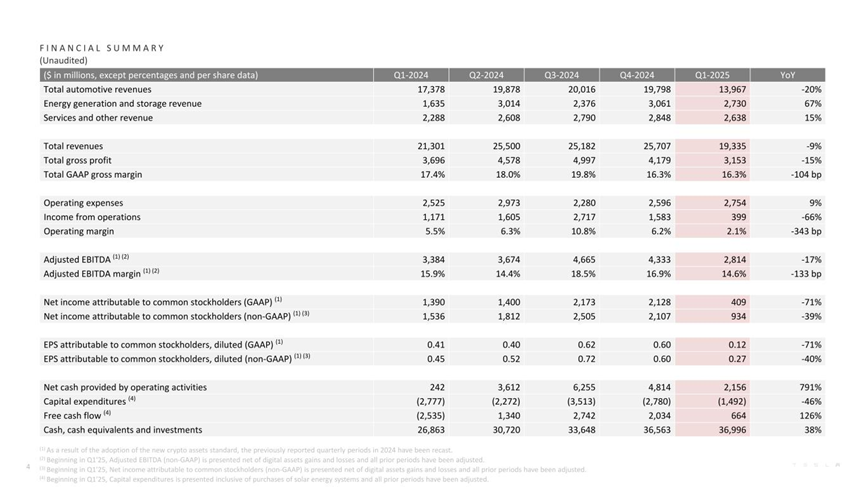
As Trump’s return to the Oval Office stirs global policy uncertainty, tech markets are showing early signs of a reshuffle. While the broader S&P 500 has staged a modest recovery from its February lows, the so-called “Magnificent Seven” of tech are no longer moving as one.

**Note that NVDA had not released its earnings at the time of writing
Beneath the surface of strong earnings, political volatility, structural shifts in AI spending, and regulatory risks are shaping a much more divided outlook.
Tesla: Political Ties and Market Pain
Tesla entered 2025 already bruised and Q1 didn’t offer relief. Shares tumbled 41% year-to-date, driven by disappointing delivery numbers and intensifying scrutiny of Elon Musk’s alignment with the controversial DOGE agency under Trump’s administration. EV deliveries fell 13% YoY to 336,681 units, and damaged infrastructure across U.S. charging networks has only compounded investor concerns.

Revenue slid to $19.3 billion, down 9% YoY, with operating income plunging 66%. Margins were slashed to a lean 2.1%. One bright spot emerged from Tesla Energy, which surged 67% quarter-on-quarter thanks to rising demand for AI data centre infrastructure. Musk’s pledge to return to Tesla full-time and fast-track a more affordable EV model triggered a 16% rally in the days following earnings but longer-term fundamentals remain under pressure. Until Tesla proves it can stabilise both production and policy optics, the path forward remains a grind.
Alphabet: Confidence in the Numbers, But No Breakout Yet
Alphabet delivered a strong quarter, but the market’s reaction was muted. Revenues rose 12% YoY to $96.2 billion, bolstered by a 28% jump in Google Cloud. The company also announced a $32 billion acquisition of cybersecurity firm Wiz entirely in cash and authorised a fresh $70 billion buyback. It’s clear Alphabet is playing for long-term strength in AI and enterprise security.

Yet despite the numbers, Alphabet’s share price remains trapped between $140 and $160. At ~17x forward earnings, it’s trading at a valuation discount to both Meta and Amazon, suggesting room to rerate. But investors appear to be waiting for a stronger near-term catalyst. Until then, the stock’s range-bound behaviour reflects broader caution, not a lack of conviction.
Meta: Growth with Legal Clouds Overhead
Meta’s earnings surprised to the upside, with revenue up 16% to $41.3 billion and EPS soaring 37% to $6.34. Daily active users rose to 3.43 billion. Strong ad pricing (+10%) and robust margins reaffirmed Meta’s dominance in digital advertising.

However, the company’s Reality Labs division remains a financial sinkhole, posting another $4.2 billion loss this quarter. More worryingly, a revived FTC antitrust case has returned to the headlines. A ruling against Meta could block future acquisitions or impose heavy fines, casting a shadow over its strategic growth.
For now, price momentum remains bullish, but the market is sensitive to headlines. Traders should monitor legal developments closely. Trailing stops and reduced exposure are advised during earnings and regulatory windows.
Microsoft: Leading the Pack
Microsoft continues to assert itself as the most consistent performer among Big Tech. Q1 revenue came in at $70 billion, up 13% YoY. Azure led the charge with 33% growth, while LinkedIn, Dynamics, and Xbox all posted healthy gains.

More tellingly, Microsoft’s CapEx rose 53% YoY to $21.4 billion, with over $80 billion earmarked for full-year AI infrastructure investment. Even with a modest 3% workforce reduction aimed at streamlining, Microsoft shows no signs of slowing down.
Institutional sentiment remains overwhelmingly bullish. With its clear AI roadmap and dominance in enterprise software, Microsoft’s valuation premium continues to look justified.
Apple: Still Solid, But Lacking a Spark
Apple beat revenue expectations with $95.4 billion (+5% YoY), but a closer look shows fatigue setting in. Greater China revenue is flat at $16 billion, iPhone growth is just 2%, and wearables declined by 5%. Meanwhile, AI capabilities remain limited in key markets like China, hampered by ongoing regulatory restrictions.

Despite the beat, Apple shares are down ~13% year-to-date. Without a major new product category or aggressive AI rollout, Apple risks falling behind the innovation curve. Investors may need more than incremental updates to regain long-term confidence.
Amazon: Leaning into Cloud and Ads
Amazon’s core retail business continues to slow but its cloud and advertising arms are picking up the slack. North American sales grew 8% to $92.9 billion, while AWS rose 17% and advertising jumped 19% to $13.9 billion. International retail, meanwhile, only grew 5%.

Tariff concerns and softer forward guidance (~7–11% revenue growth) have weighed on sentiment, but structurally, Amazon is shifting toward higher-margin segments. Traders should watch for outperformance in AWS and advertising KPIs as drivers of share price upside.
The technical picture suggests consolidation, but a breakout is possible if AWS acceleration continues in Q2.
The Bottom Line: Follow the AI Capital
The divide in tech earnings is becoming clearer. Companies aggressively deploying capital into AI infrastructure, like Microsoft, Meta, and Alphabet, are attracting stronger institutional support. Others, like Tesla and Apple, are contending with policy risks, execution delays, or product fatigue.
This quarter makes one thing clear: the “rising tide” narrative no longer applies. Selectivity is key. Traders should favour names with robust earnings, strong CapEx in AI, and stable leadership through macro headwinds. These are the names that will drive alpha in the second half of 2025.









